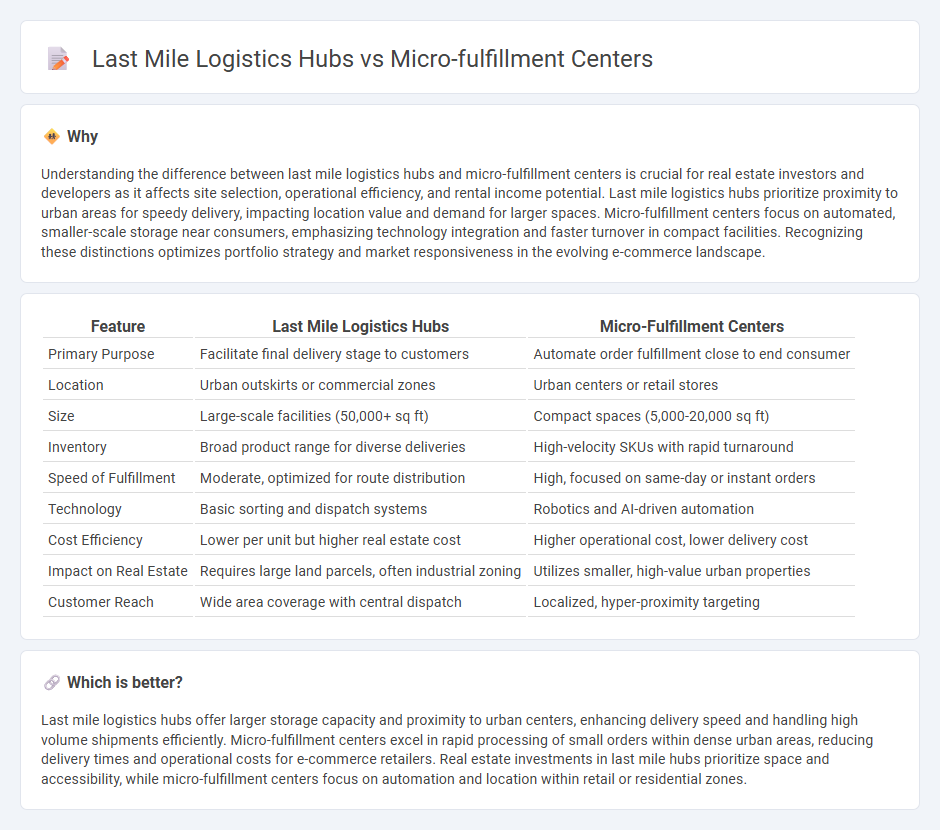
Last mile logistics hubs are strategically located facilities designed to streamline the final step of delivery, prioritizing speed and efficiency for urban and suburban areas. Micro-fulfillment centers are smaller, highly automated warehouses positioned close to consumers, enhancing inventory management and reducing order processing times. Explore how these real estate solutions are transforming supply chains and reshaping urban commerce.
Why it is important
Understanding the difference between last mile logistics hubs and micro-fulfillment centers is crucial for real estate investors and developers as it affects site selection, operational efficiency, and rental income potential. Last mile logistics hubs prioritize proximity to urban areas for speedy delivery, impacting location value and demand for larger spaces. Micro-fulfillment centers focus on automated, smaller-scale storage near consumers, emphasizing technology integration and faster turnover in compact facilities. Recognizing these distinctions optimizes portfolio strategy and market responsiveness in the evolving e-commerce landscape.
Comparison Table
| Feature | Last Mile Logistics Hubs | Micro-Fulfillment Centers |
|---|---|---|
| Primary Purpose | Facilitate final delivery stage to customers | Automate order fulfillment close to end consumer |
| Location | Urban outskirts or commercial zones | Urban centers or retail stores |
| Size | Large-scale facilities (50,000+ sq ft) | Compact spaces (5,000-20,000 sq ft) |
| Inventory | Broad product range for diverse deliveries | High-velocity SKUs with rapid turnaround |
| Speed of Fulfillment | Moderate, optimized for route distribution | High, focused on same-day or instant orders |
| Technology | Basic sorting and dispatch systems | Robotics and AI-driven automation |
| Cost Efficiency | Lower per unit but higher real estate cost | Higher operational cost, lower delivery cost |
| Impact on Real Estate | Requires large land parcels, often industrial zoning | Utilizes smaller, high-value urban properties |
| Customer Reach | Wide area coverage with central dispatch | Localized, hyper-proximity targeting |
Which is better?
Last mile logistics hubs offer larger storage capacity and proximity to urban centers, enhancing delivery speed and handling high volume shipments efficiently. Micro-fulfillment centers excel in rapid processing of small orders within dense urban areas, reducing delivery times and operational costs for e-commerce retailers. Real estate investments in last mile hubs prioritize space and accessibility, while micro-fulfillment centers focus on automation and location within retail or residential zones.
Connection
Last mile logistics hubs and micro-fulfillment centers are integral components in modern real estate strategies, enhancing urban distribution efficiency by reducing delivery times and transportation costs. These facilities are strategically located near high-density residential and commercial areas to optimize real estate utility and meet growing e-commerce demand. Valuable real estate assets in prime urban locations are thus transformed into vital nodes supporting rapid order fulfillment and last mile delivery networks.
Key Terms
Inventory Management
Micro-fulfillment centers prioritize rapid inventory turnover with automated systems designed for high SKU density and localized stock allocation, enhancing order accuracy and reducing fulfillment times. Last mile logistics hubs focus on staging pre-sorted inventory for final delivery routes, emphasizing real-time inventory visibility and cross-docking to optimize shipment consolidation. Explore how integrating these strategies can revolutionize your inventory management efficiency.
Proximity to End-Consumer
Micro-fulfillment centers are strategically positioned within urban areas to maximize proximity to end-consumers, enabling rapid order processing and same-day delivery. Last mile logistics hubs, while also near consumer locales, typically serve as larger distribution points focused on consolidating shipments and optimizing delivery routes. Explore detailed insights to understand which model best enhances delivery efficiency and customer satisfaction.
Facility Footprint
Micro-fulfillment centers typically operate in smaller, automated spaces ranging from 10,000 to 50,000 square feet, designed to expedite order processing within urban environments. Last mile logistics hubs generally require larger footprints, often exceeding 100,000 square feet, to accommodate extensive vehicle fleets and sorting operations for broad distribution. Explore the differences in facility design and operational efficiency to understand their impact on urban supply chain solutions.
Source and External Links
Micro-Fulfillment Explained - Micro-fulfillment centers are small warehouses strategically located in urban areas, enabling faster and more efficient order fulfillment by placing inventory closer to consumers.
Micro-Fulfillment Guide - This guide provides an in-depth look at micro-fulfillment centers, including examples of companies like Gopuff and ShopRite that have successfully implemented them.
What Are Micro Fulfillment Centers? - Micro-fulfillment centers are compact warehouses, typically 3,000 to 10,000 square feet, designed for rapid shipping of high-demand products.
 dowidth.com
dowidth.com